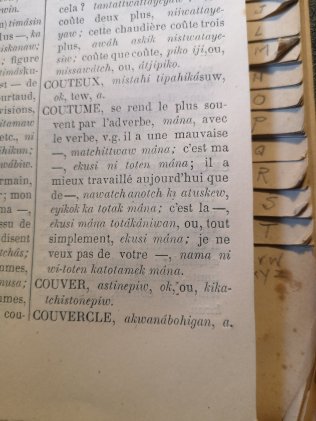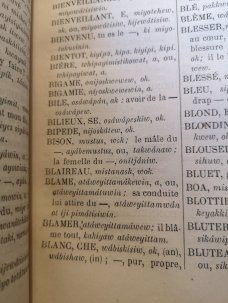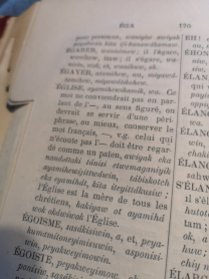UNESCO has designated 2019 as the International Year of Indigenous Languages. I currently live in Treaty 6 Territory, which is the traditional homeland of the Cree, the Dene, and the Metis, among others. (Use this website to find out whose territory you reside on if you are unaware already – or use it to look up familiar places!) I’ve been learning bits and pieces of the Cree language for several years now and I want to make accelerated effort at it this year of all years. I’m lucky that several of my staff members are Cree language learners and we have opportunities to try to learn and to use it in the work place. These are living languages so it’s important to use them; languages shape how we describe and see the world. I want to highlight some resources and sources of information about Indigenous languages, and encourage people to learn and use Cree.
As a historian, I’m fascinated by delving into the history of languages like Cree; I often use historical sources as a lens through which I view a topic I’m learning about. I’ve written before about people like Peter Erasmus and other Old Timers, people both from Cree-speaking cultures and not, who all commonly spoke Cree as a lingua franca in this territory in the 19th century.
The oldest book I personally own is a copy of Father Albert Lacombe’s Cree-French dictionary. I bought it from a book seller at the American Bison Society Conference in 2016 in Banff. I find the materiality of this book fascinating. Before it came into my possession, it was rebound (it has an English-language spine) and spent time in a library (it has a call number on the spine too), I think in British Columbia. Pasted in the back, there’s a pair English-language newspaper articles from the 1970s about the preservation of the Cree language and also Father Lacombe’s life. (I didn’t realize that his mother was half-Anishinaabe?)
One of my favourite details about the book is that someone at some point in its history has trimmed the edges and written in the letters of each section for ease of reference. It’s clear from the condition of the book that it was well-used.
This book had a clear audience and purpose; it was to teach prospective missionaries the Cree language so they could better convert and minister to Indigenous peoples. It only goes one way: translating French concepts into Cree. That’s reflected in the introduction. It is a book of its time, and it is trying to share knowledge of Cree people with an audience that already has a lot of preconceived notions about them.
For those who can’t read French, this page and the one following reads something to the effect of:
The Savage Languages / The Wild Languages
A lot has been written and spoken of the savage languages of North America. Some souls, who see themselves capable of judging everything, and deciding on questions outside of their competencies, have poorly appreciated savage languages. This new group of Indian-ologists, having spent a little bit of time among the Indians and after gathering a certain number of words, often very poorly written, have come to believe that these dialects are nothing more than inarticulate, truncated debris, almost unintelligible, and that they are not real languages. Others, in contrast, are better appreciators and are in a better state of judging (and we place missionaries in the first rank of these), after long studies and several years passed among the savage tribes, and have recognized that the poor child of the prairies and the woods have a regular language, intelligible and not without its beauty, with which they can transmit with sounds all that takes place in their soul. Even more than that, the savage, in speaking his language, speaks it correctly from a young age, and he is amazed to hear someone make the least grammatical mistake…. Savage languages in general are rich in vocabulary and in grammatical forms. In their complex structures, we find the grandest order and a most regular methodology.
Father Lacombe was fluent in both Cree and Blackfoot as well as French, but he was speaking to an audience that had to be convinced that First Nations actually had language, and that it was a complex one with its own beauty. That is, uh… quite a low bar for baseline knowledge.
Lacombe seems to quite admire Cree and favorably compares it to French:
La langue des Cris est belle, riche et peut-être la plus facile de toutes les langues sauvages de l’Amérique du Nord. On peut dire que le cris est pour le Nord-Ouest ce que le français est pour les pays civilisés.
The language of the Cree is beautiful, rich, and perhaps the easiest of all of the savage languages of North America. One could say that Cree is to the North-West what French is for civilized countries.
Lacombe in his introduction scatters about Cree words, and occasionally gets a dig in at the English. In a footnote explaining the origin of the name of the Saskatchewan River:
Ce mot est défiguré par les Anglais et ne veut rien dire en cris. Il faudrait : Kisiskatchiwan, courant rapide.
This word has been disfigured by the English and doesn’t mean anything in Cree. You should use Kisiskatchiwan, swift current.
Father Lacombe was an interesting figure at the intersection of several communities and cultures. He was a peace maker but also an agent of colonialism; he was beloved and did both harm and good. All of things can be true at once. His book in its attention detail does seem to show admiration for the Cree language… and yet it has a clear (and understandable) focus on Catholic terminology, intended in large part to supplant parts of that culture. He often has to clarify that Cree doesn’t quite have a word that means that, or that this word could be used in that way but has unexpected connotations. For instance, in his definition for “to adore” (as in “to adore the Christ child”), he includes a note (my incredibly rough translation):
We could also say manitokkâtew, but this expression seems improper here, because it really means he is like a God, a phrase better suited for idols and objects of superstition. The word manâtjihew, used in prayer to mean to adore, is not quite suitable either, as it means simply that he respects [it], he has regard for him.
He also really struggled with “superstition” and “superstitious”, and ended up effectively just listing superstitious acts (ceremonies) in Cree.
As someone who is fascinated by linguistic history, this focus on how to translate biblical passages and catholic catechisms, as well as pejorative translations of Cree culture, is not surprising but it is interesting, illustrating how language can be used (and mangled) to communicate a very specific message. That being said, Lacombe records very specific cultural concepts, including for instance a specific word designating the act of crying in very specific circumstances. Other words frame European concepts in a way that is more comprehensible to the Cree, framing their concepts as normal and the Euro-Canadian ones as those needing clarification. The word Lacombe lists for domestic cattle, for instance, includes the word “slave”, framing them as “enslaved buffalo”. The dictionary is fascinating to me because of its specificity of language and window into Cree culture at a time of encounter and change.
However, I have to acknowledge here that I am interpreting the history of this language through the lens of Father Lacombe and the languages that he spoke, that he and I share. That means I am trying to access this information about Cree language and culture already from an outside perspective. It’s a fascinating one to me that resonates with my experience, but one that holds a certain worldview. Father Lacombe chose to include words that he felt his audience would find useful – they betray a certain obvious focus and perspective. Dictionaries are not impartial lists of vocabulary. They are written with a purpose.
Material objects are a tangible link with the past. One thing struck me when I was handling this book last year: its publication date. It was published in 1874. What was happening at that time? Treaty 4 was signed that year. Bison populations were in steep decline. That was also the year when Samuel Walking Coyote (or Peregrine Falcon Robe) captured a small seed herd of bison that would eventually become the Pablo-Allard herd from which a majority of Plains Bison are descended from today. Judging from notes and stamps on the inside cover, by the 1960s this particular copy had found its way to Victoria, BC. What happened to it in the 90 years in between? Who used it? Did it make its way to Treaty 6 territory in the 19th century? By canoe, horse-drawn cart, or later by train? Or was it purchased and kept in Quebec for decades before making its way to British Columbia by car or by plane? Who used it so often they needed to trim the edges of the pages for easy reference? Was the most useful period of its life before or after it entered into a library? How did it come to be on that bookseller’s table, where it caught my eye?
When I hold this book, I think of who else could have held this book, and both how near and yet how far we are to their world.
Note
I am not a native French speaker, and I welcome corrections on my rough interpretations of the French elements of the text. I also welcome insight from any Cree or French speakers about what they read here!
Further Reading
- History of the Cree Language talk by Reuben Quinn
- For a more modern dictionary accessible to English speakers: Cree Dictionary Online
- Wordreference.com: a useful resource for people who frequently translate between English and French, or for those of you who want to puzzle over my translations.
- A bit about territorial acknowledgements
- Media Indigena: a podcast that provides an Indigenous perspective on the news (because I shouldn’t just be reading what settlers have to say about Indigenous language and culture – I should be listening to Indigenous people).
















Pingback: Canadian History Roundup – Week of June 30, 2019 | Unwritten Histories